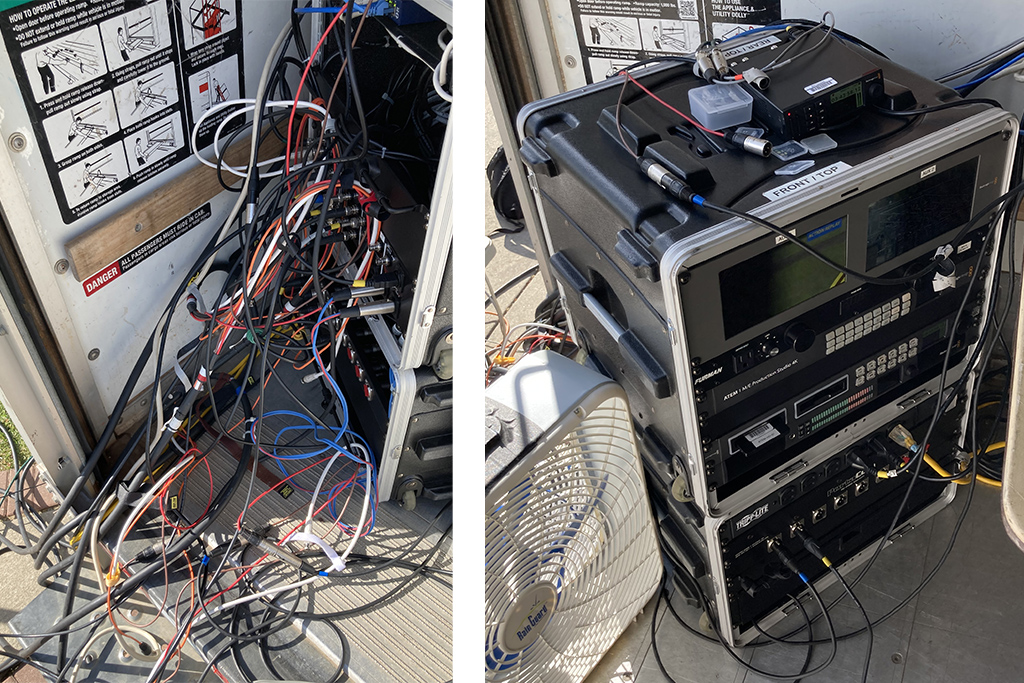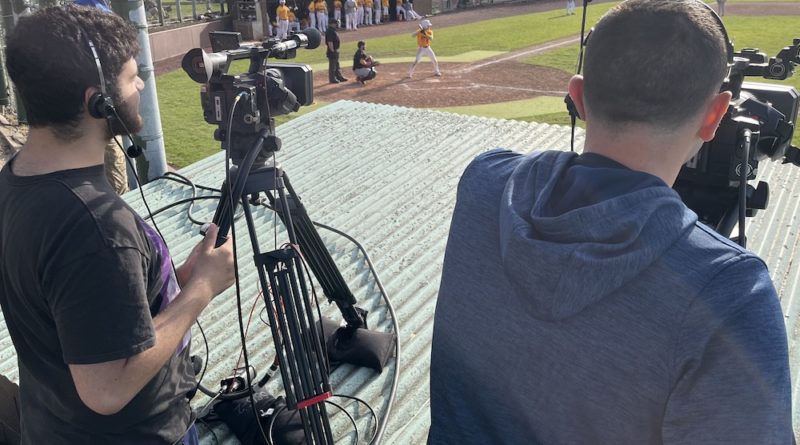College baseball live coverage with 5 cameras, tech from the 90’s and today, a box truck, and eager students


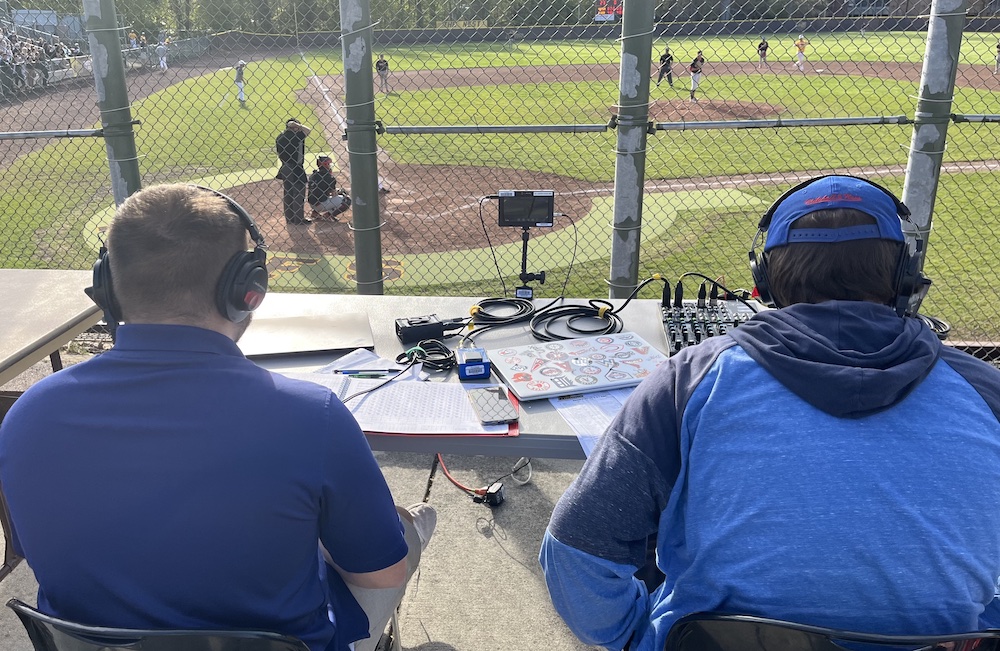
Towards the end of each semester, students in my Sports TV Production course participate in livestream game coverage of baseball (spring semester) or basketball (fall semester) games at Rowan Univeristy (Division III). The bulk of the course focuses on production of a sportscast program series, and for that project work the students produce, shoot, edit, write, direct, and serve as talent for their shows (check out Profs Huddle on YouTube). So when we shift gears to the live game coverage, a much smaller aspect of the course, it’s all about the experiential learning and participation – the students in this class may have never worked in live event situations before (there’s another course I teach that handles that exclusively, though not just for sports content). The goal is to get students some experience in a semi-professional situation in which livestream mulitcamera coverage of a game is employed. Depending on their own skills and interests, students may work as camera operators, graphics operators, audio mixers, replay operators, technical directors, and commentators. In class, we go over the basics of live coverage approaches, role responsibilities, key requirements and achievable goals for our production efforts. While we address similarities and differences between play-by-play and color commentary, as well as the comparison of commentary on radio broadcasts versus television broadcasts, other courses do the deep dive into broadcaster techniques and honing on-air skills. This course project gives students interested in on-air work an opportunity to do some real-world game calling.
While the students are eager to get involved, and willing to do just about anything from hauling cables to presenting the game on-air as commentators, there are many challenges faced in production, and even pre-production, just to get the show on the air. Some of these areas are common across broadcasting and higher education, and others are unique to our situation as a young course (first run in Spring 2020) and sports media program (launched in 2018).
BIGGEST CHALLENGE: Crewing. I had a class of 17 eager students in Spring ’22 and of the six possible game days the class could have covered, we picked three for which participating attendance would be at least 7 students. Games don’t coincide with class meeting day or time, so it’s an issue of availability on gamedays for both students and me. The highest attended game coverage for the class was one game w/ 10 students. Students were required, if scheduling allowed, to show up for at least one game including setup & strike, but encouraged to come out for as much as possible for the experience. Generally, most students were able to attend 2 of 3 event opportunities.
A SIGNIFICANT CHALLENGE: Rowan’s baseball stadium wasn’t built with video coverage in mind and hasn’t undergone renovation to make it more TV-friendly, ever. The typical “high home” shot in baseball is impossible to achieve here without shooting through an industrial-grade chain link fence from ground level. The ground isn’t level immediately behind the fence so getting a skylift or elevated platform in place temporarily is a no-go; this is also where all of Rowan Athletics staff and other commentators (Rowan Radio) set up shop; there is no such thing as a press box here. Spectator stands are well behind & beyond first and third bases, not advantageous for camera placement. The one saving grace is that the outfield shot showing pitcher/batter can be perfectly achieved when shooting from the second floor of a parking garage just beyond the outfield fence (see photo below). To functionally replace the “high home” shot, there’s a camera at first base side shooting “game”, concentrating on action happening towards left & center field; there’s another camera at third base side shooting “game”, concentrating on action happening towards right & center field. Whichever one gets the better shot faster goes on-air.
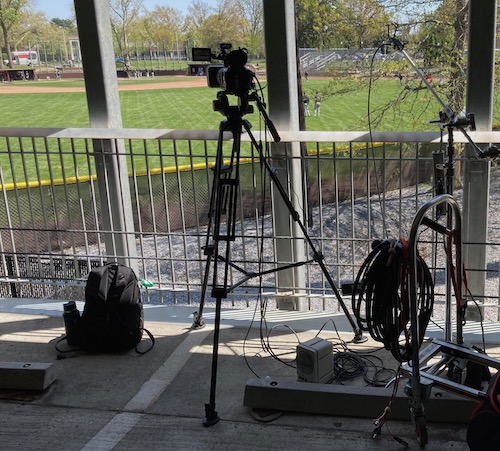
TO COMPLICATE MATTERS: All of the production gear is used in normal rotation for this and other courses; there is no dedicated production van or truck, or equipment specifically designated for sports coverage. So everything (including approximately 150 individually scanned items as well as another 20+ visually inspected components) has to be booked, checked out, used, and checked in, a-la-carte, every time.
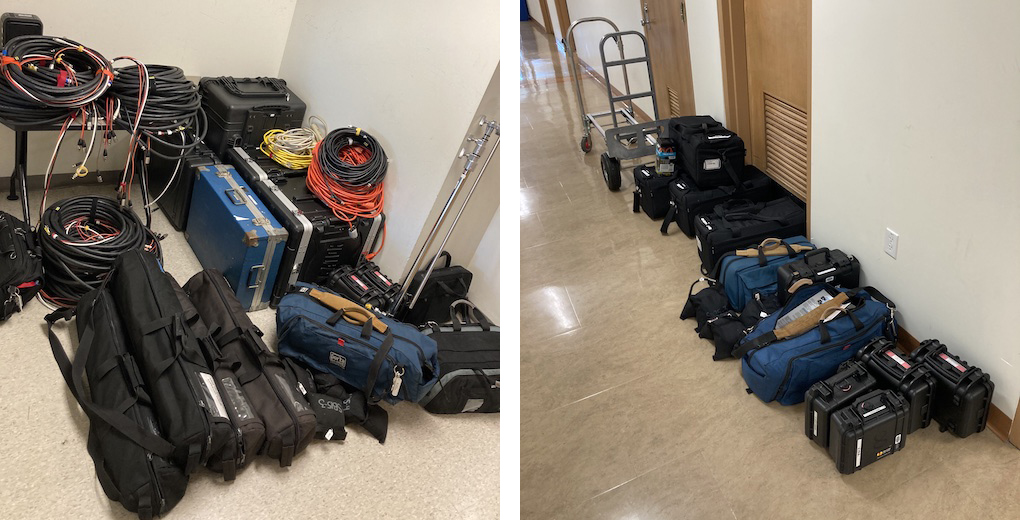
CUE THE ROLLING CONTROL ROOM: Remember when I said there’s no press box? With no press box, and no actual technologically equipped production van, truck or trailer, typically our flypack (portable control room systems) gets set up out in the elements on folding tables, subject to sun/glare/burn, wind (including blown sand/dirt), rain, and everything you don’t want in a control room (bees were a thing too). This year I rented a box truck for gear transport and to serve as the control room on wheels. After taxes, fees, and mileage costs (5 miles round trip), it was well worth the ~$60 per outing – if nothing else, fewer trips from our academic buidling to the baseball stadium, and a temporary shelter for our control room configuration. The inside setup was the same flypack-on-tables that would normally be outside, but it was all shielded from the weather elements. This became critically important for one game that went four innings before the skies opened up and downpoured for 20 minutes. That game was subsequently called off and except for two minor audio accessories that were out in the rain and needed a little reconditioning, all the other head-end gear was safe and mostly dry.
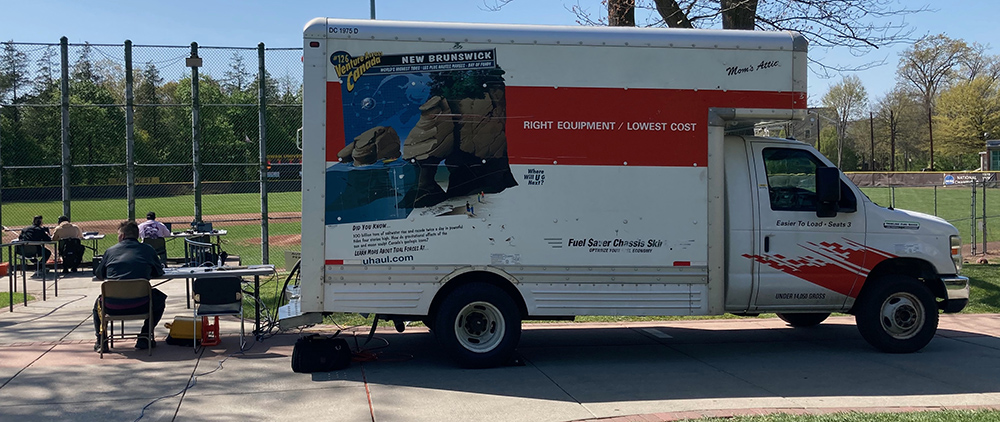
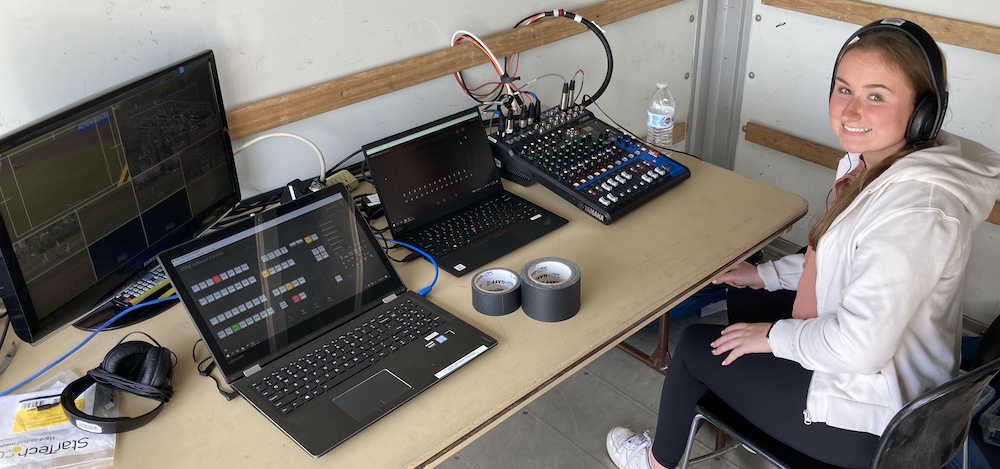
WIRED vs WIRELESS: We used 5 cameras, 4 locally wired via coax cabling (SDI/BNC) and the parking garage camera was transmitted via wireless (Teradek Bolt 750) with very low latency, approximately 475ft line-of-sight. Intercom to the 4 wired cameras was via PortaCom wired system (analog audio + power, 2-channel over standard 3-pin XLR) but we don’t have a true wireless intercom solution… Cue the ingenuity! Take a closed double-ear headset from the intercom system via wired beltpack interface. Insert a lav mic between the two earphones, tape the headset system shut with the lav mic inside. Plug the lav into a wireless mic transmitter. At the camera in the parking garage, output the wireless mic receiver to headphones or a powered speaker… and the camera operator can listen only. Equip the camera operator with a 2-way radio to talk (if needed), put another 2-way back at the “truck” and we have pseudo wireless intercom. Use C-stands to elevate the antenna positions, secure the cables, and it’s a clunky yet very practical solution.
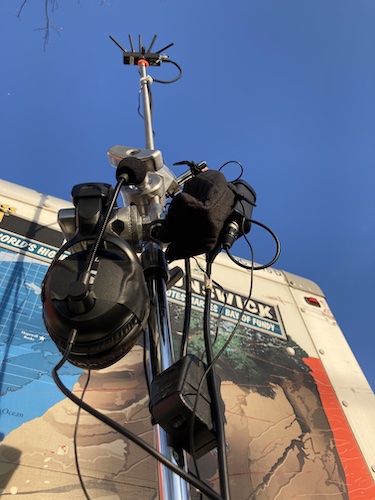
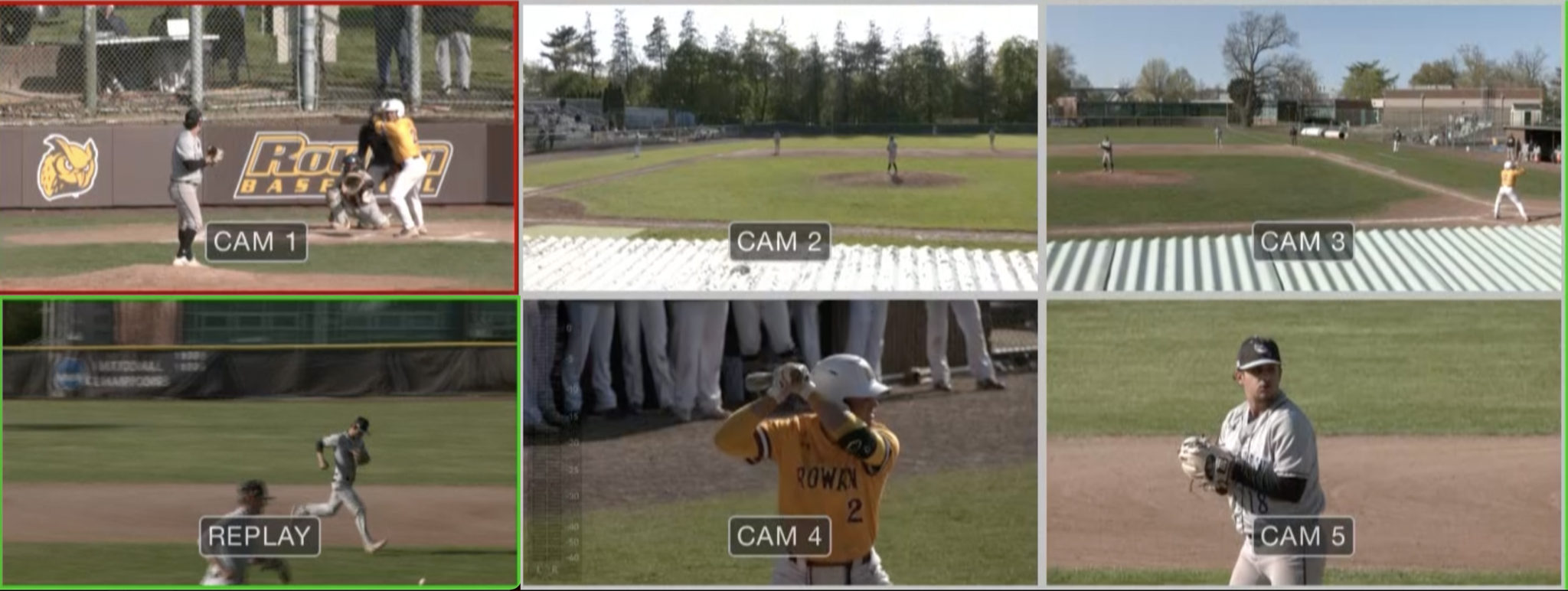
REPLAY – see below…
WHEN THIS BABY HITS 88 MILES PER HOUR… So by now you’re wondering, what’s the tech from the 1990’s? Let’s roll the tape! Well, that’s what we said back in the analog video days. Before fancy computer editing we used good old-fashioned linear editing (tape-to-tape), and to facilitate the edits, we had linear edit controllers. These devices could control up to four playback decks and one record deck, plus interface with a video switcher for programmed transitions (go ahead and research “A/B Roll Linear Editing”). The serial control protocol (RS232) used in pro remote controllers and VTR’s from the 80’s and 90’s is still built into recorders & players today – such as our BlackmagicDesign HyperDeck. Instead of videotape, we use SSD’s (solid state disks), which are lighting-fast and perfect for nearly-instant replay. Using the jog/shuttle wheel on the controller, along with MARK IN point identification and timecode (if you really want to get precise), the replay op can cue up the most recent play as soon as it’s completed. In real instant replay systems, the system is always recording so the replay op can cue to the start of the clip while the play is still occurring. A traditional VTR-type device can only play back or record, not do both simultaneously. Note: We tried this with our BMD HyperDeck Mini and found that even though the control protocol worked here too, the SDXC cards were not fast enough to quickly cue and play back media “immediately” after recording. Using our flypack system and the BlackmagicDesign ATEM 1 M/E switcher, replay could record an AUX switcher output that could have its source dynamically changed by the opertor, grabbing an individual camera, or a combination of cameras cut in realtime, or the program linecut. Through experience, student operators learned that the “best” replays were multi-source cuts, though hard to do, and the fastest/easiest cued for playback were individual camera ISO’s.
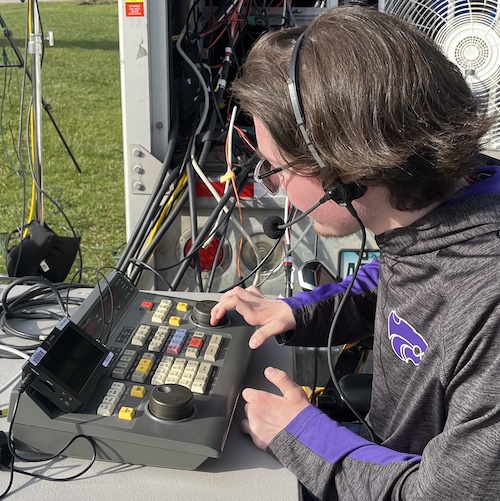
GRAPHICS NOT INCLUDED: Given limitations of budget & resources (including time), graphics were not included in these productions beyond the scorebug graphic, which was inserted downstream by Rowan Athletics / Athletic Communications staff ahead of the push to YouTube (we supplied the coverage, they facilitated the stream). Long-term, this live sports coverage project will be siphened off into a course on its own, for students to produce live sports programming on a regular basis throughout the semester. For now, it’s limited, basic live coverage for a video stream that surpasses the typical single-camera coverage provided for all events by Rowan Athletics.
WHERE TO GO FROM HERE? We have a lot of students who are interested in these production efforts, so student engagement and passion to produce is readily apparent. To match that energy and get to the “next level”, and be able to run a course that does sports event livestreaming exclusively in a proper polished, network program level-styled presentation, we’d need a serious investment in tech/gear and infrastructure. Here’s what we need to make it to the “big time” level of production capability:
- A dedicated production van, truck or trailer to permanently house the equipment as a mobile control room and be 100% self-sufficient for power, lighting, video, audio and network connectivity necessary for productions. ALL the gear travels together including cameras/tripods, microphones, cabling, etc., so that it doesn’t need to be individually checked in and out every time. The reason this project occurs at the END of a semester is because we can’t take this much field / camera / audio equipment out of general rotation repeatedly mid-semester. By the end of the semester most courses are into post production, freeing up field gear. While REMI models are the wave of the future – er, present – our campus network infrastructure is not robust enough to support REMI production models, and would limit operations to strictly on-campus.
- Professional live video camera “studio” component systems including:
- Fiber optic infrastructure for camera cabling – carrying main video, return video, power, CCU remote control, intercom, etc., and not limited to 100m runs.
- Professional grade viewfinders – large, 7-9″ rear-mounted viewfinders w/ glare hoods, focus peaking, tally indication
- Rear-mounted zoom/focus controllers
- Remote CCU operation for shading & painting control
- A better wireless video system for wireless camera operation – something more portable & fully battery operated at the camera (likely need an ENG style camera upgrade for this)
- Higher-end control room production equipment – 2 M/E switcher, live titling graphics & effects w/ motion graphic wipes & animations, an actual contemporary instant replay system, improved video playback & recording systems, digital audio mixing console w/ analog I/O breakouts, maybe a router (64×64), more & bigger monitors. Bigger field monitors for talent too! We’re running on one consumer-grade 24″ multiviewer monitor plus 5″ monitors for everyone/everything else.
- Multichannel digital matrix intercom, wired (integrated with cameras & control room) w/ wireless capabilities for roving positions – camera, talent, stage manager, etc.
- Producer/Talent IFB
In terms of producing, dedicating a whole course to this type of production effort alone, specifically focused on sports, could allow for students to work on…
- Pregame/postgame shows, halftime / mid-inning reports
- Sideline reporting in addition to typical play-by-play and color commentary
- Creation of short edited packages, interviews and other pre-produced content. A show open, bumpers, and in-game highlights / recaps specific to each game would be great to see.
- Enhanced graphics & aninmations, wipes, statistical presentations and player/game analysis (that’s really next-next-level, but why not?)
AND NOW FOR MY FINAL THOUGHT(S)… I am always trying to push my courses, my teaching, and my students’ experiences and proficiencies to the next level, recognizing limitations and strategizing how to overcome them. With current resources and my own sanity hanging in the balance at times, there is only so much that can be done in the present. Given all of the above, we can already achieve decent live sports coverage. It takes a lot of time, effort, thinking, planning, day-of-production sweat and a bit of head-scratching to get all the puzzle pieces to fit together into a coheisve picture. It’s also a significant production on a very small budget with a very small crew consisting of students still getting their feet wet in this pool. The students learn a lot on multiple levels – importance of pre-production, importance of safety issues (baseball is a “heads-up!” sport), production and coverage techniques, and they get a feel for life in production outside the confines of the studio and classroom. But what we all collectively achieve could be much greater. Right now, we’re at the first fundamental stage of coverage – it’s complete and effective, but not really a “show” at this point. This doesn’t give students sufficient practical experience in creating contemporary television style live sports programming. Is it a worthwhile experience nonetheless? Absolutely! Realistically speaking, it’s also the result of hobbling together a lot of gear that wasn’t intended for this purpose originally, but we’ll squeeze every ounce of live production capability out of it as possible. Should we be running replays on a linear edit controller from the 90’s? No one should, but that’s what we have, and we can & will use it for as long as it works without a higher-level professional alternative. There are plenty of professional operations working in low-budget situations that would spend good money on eBay to get a linear edit controller with RS232 protocol control just to do what we’re doing now – so it was a stroke of pure luck that we had one in storage, dusted it off, and it worked… with cable included! In the end, the viewer has no idea how that replay got there, all they know is that it’s there and it adds value to the coverage for an improved viewing experience. It is also one more position a student can try out and get a feel for, knowing that it’s “like this” professionally but a better experience with more professional gear to do it properly in a contemporary setting. Overall this project gives students a leg-up on their internships and entry level / part time & freelance jobs working in a live sports coverage situation, getting an idea of how everything works together and how critical each bit of detail is for the success of the whole operation. Professional preparation with practical experience – that’s the ultimate goal as this is, at the most basic level, an academic experience. The Sports TV Production course only started in Spring 2020, and through the COVID-19 pandemic to now, we’ve only had three semesters of active intercollegiate athletics. The first outing (baseball in Spring ’21) was a lot of trial-and-error; the second outing (basketball in Fall ’21) was the same but also different in many ways; this Spring ’22 is “third time’s the charm” and I’d consider it an absoulte success given all the constants and variables. My other course, Live Event TV & Video Production, only started in Summer 2016 and uses a lot of the same equipment… so as we only have 1 flypack system, there can only be 1 live coverage event at a time despite the multitude of opportunities for live sports & event coverage at Rowan University. A modular flypack system with an assortment of a-la-carte gear options has its usefulness and convenience in some cases, but it’s not the only way to do live sports & event production – it just happens to be the only way students in my courses can do live field work… so far…. which is far more than what I could do when I was an undergraduate student. Multicam live production outside of the studio setting was next to impossible 20+ years ago for college students without professional big-budget production resources. Imagine how we’ll be doing this 20 years from now…
